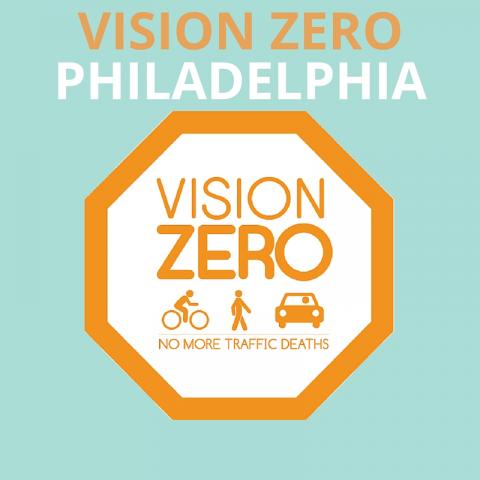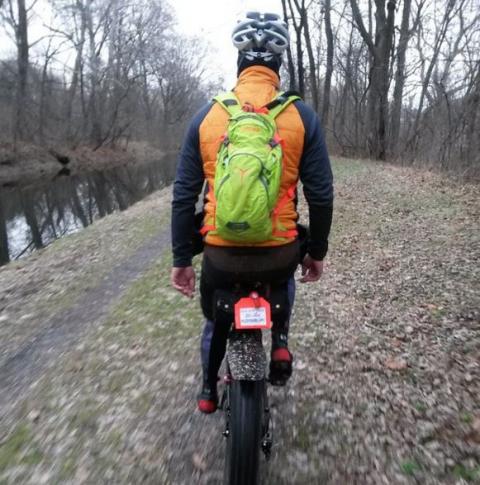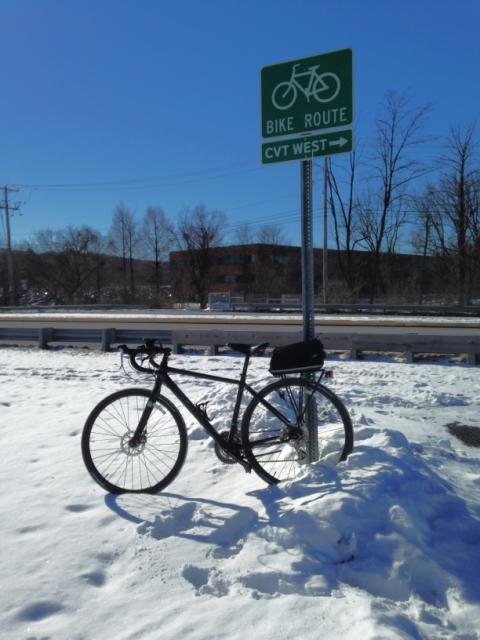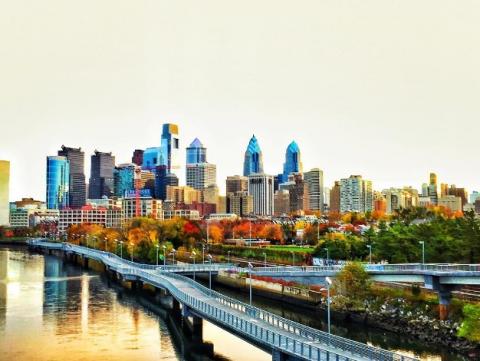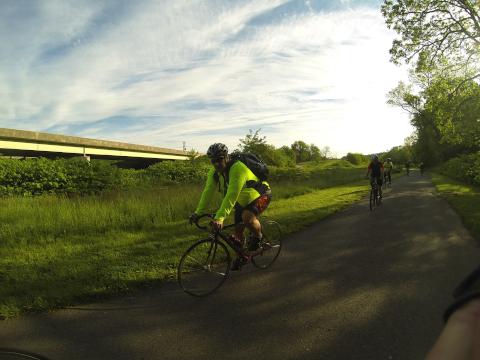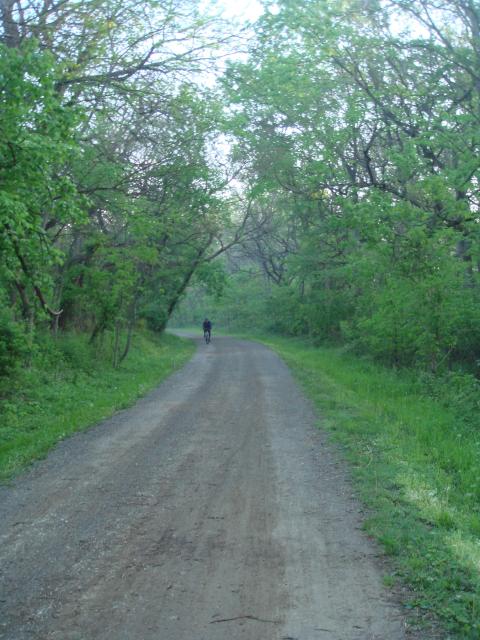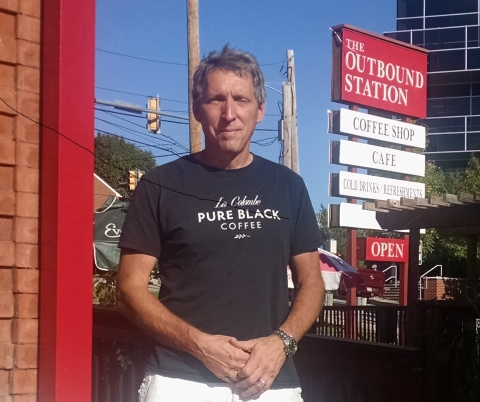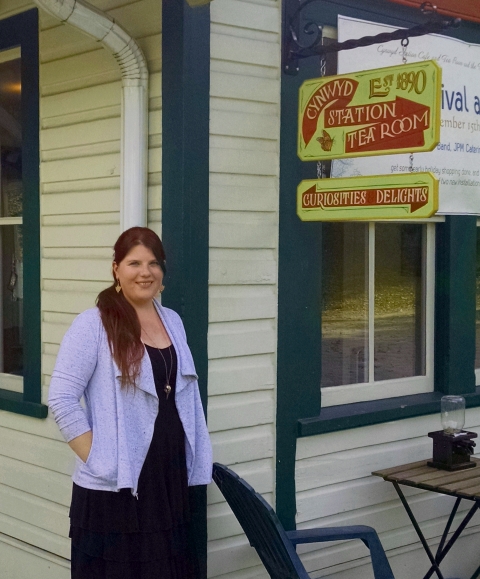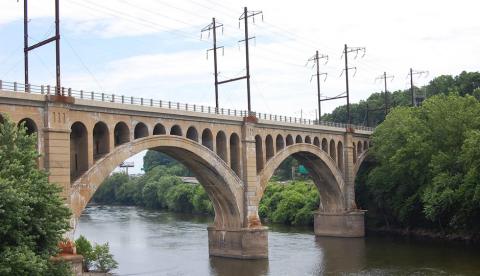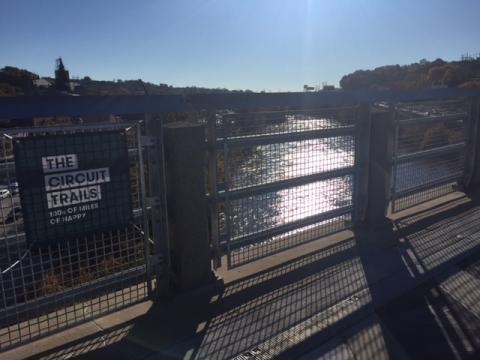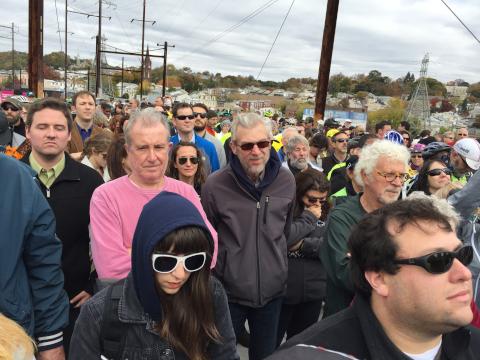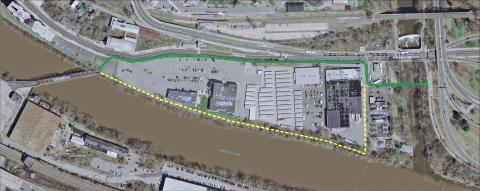You are viewing all posts
Summary of November 2015 Semi-Annual Circuit Trails Coalition Meeting
Twice a year, the Circuit Coalition convenes for a two hour meeting to review progress and accomplishments from the six months. Here is a review of the Semi-Annual Circuit Trails Coalition Meeting held on November 19th:
Traditional, Shared, and Social Media Report
Brianna Taylor of Devine and Partners (D+P) reported that Circuit media efforts have reached over 130 million people through more than 141 online and broadcast placements. These media placements have an estimated value of over $400,000. The D+P team also reported that the Circuit Trails' hashtag: #onthecircuit has gained traction across social media platforms. Additionally, social media advertising and boosted Facebook posts have been very successful, generating 82% of all Facebook likes. See her presentation here.
Branding Campaign Update
As discussed by Katie Harris of Rails-to-Trails Conservancy, the new Circuit Trails logo was soft-launched at the end of October! The "Proud to Trail" campaign and new website will launch in the spring with the opening of trail season.
Mileage Update
Chris Linn of DVRPC reported that 28 miles of Circuit Trails were completed between May 2012 and May 2014 and 12 miles were completed between May 2014 and November 2015. Forty-one miles are expected to be finished by late 2018. Nearly one hundred miles are in the pipeline which means they are either under design or studies have been completed.
Circuit Surveys
Tom Sexton, Liz Sewell, and Anya Saretzky of Rails-to-Trails Conservancy reported on the trail user surveys program. Survey types include trail-side, intercept, focus group and phone. Results show that most trail users are unaware of the Circuit Trails and that trail use results in significant economic impact for local communities.
DVRPC Trail Use Count Update
DVRPC’s Shawn Megill Legendre reported that there are now 12 permanent counters on trails throughout the region. Trails that are better connected and are close to where people live and work have higher usage levels. All of the data is public and can be found here for permanent counters and here for short term counters.
Case Studies and Lessons Learned
Olivia Glenn of the New Jersey Conservation Foundation, Sue Brennan of Coopers Ferry Partnership, and Jack Sworaski of Camden County presented about the Cooper River Trail which runs through five municipalities. Their lessons learned can be summed up as “PEDAL” - Persistence & Partnerships, Easements & Education, Diversified funding streams and programming, Advocacy, Local engagement.
Paul Gordon from Bucks County Planning Commission and Michael Stokes from Montgomery County Planning Commission spoke about the cross-county partnership that is building the Pennypack Trail. Key takeaways include using county dollars, saving money by keeping labor in-house, and growing public support by building the trail one section at a time to let people see what the trail will look like.
Dedication Ceremony of Phase 1A of Delaware Avenue Extension
‘Never say never’ was the theme that followed Wednesday’s dedication ceremony in Bridesburg. Community members and city leaders convened Wednesday to celebrate the opening of Phase 1A of the Delaware Avenue Extension project – a new 0.6 roadway and trail project built along the Delaware Riverfront Greenway in Northeast Philadelphia that has been in discussion for more than 20 years!
Phase 1A of the extension, connecting Port Richmond to Bridesburg, includes a 0.6-mile section of new roadway, a bridge over the Frankford Creek and an adjacent multi-use trail segment extending from Lewis Street to Orthodox Street.
Officials, including Mayor Nutter, Denise Goren, director of the Mayor's Office of Transportation and Utilities, Deputy Mayor Michael DiBerardinis, Commissioner of Streets Department David J. Perri and Former U.S. Congressman Robert Borski as well as Tom LaCroix, an active member of the Board of the Bridesburg Business Association gave remarks at the ceremony and reflected on the impact the project has already had on the Bridesburg community as well as Philadelphia. Mayor Nutter commented that the project is a “win, win, win,” providing a vital, direct route to and from I-95 for the industries, improving access to the waterfront and relieving the Bridesburg community of significant truck traffic on their neighborhood streets that has been degrading their quality of life.
And while the new road segment alleviates the truck traffic, the new multi-use trail opens opportunities for residents to broaden their own transportation choices and accommodates pedestrian crossings. As the project evolves, the trail will be used for commuters to bypass traffic congestion and ride right along the river to get to work.
Goren described the project as the first new road to open in the city in 30 years. When speaking about the new trail Deputy Mayor Michael DiBerardinis commented on how far we’ve come, adding that trails have become an integral part of Philadelphia. The addition of a multi-use trail was an integral element, especially when considering residents’ quality of life. Residents (for decades) have requested access to the river for recreational use. Now, residents can take advantage of this unseasonably warm weather and get out on the trail!
And local residents have already seen the positive impact! A resident on Orthodox Street commented that traffic volume has decreased on his street since the road was opened in late November. The resident also observed significant more yellow school busses on Delaware Avenue. The bus operation is at the end of Orthodox Street and, prior to the opening, bus drivers had no choice but to use Orthodox and travel through the neighborhood – creating further traffic congestion! As the project evolves, a trail will be built at Magee Street, located at the back of a Charter School currently in development, allowing students from neighboring communities to use the trail to get to school.
The federally funded $14.5 million project, which broke ground last spring is yet another reminder of the power of collaboration, perseverance and vision. “This multi-layered project shows just how much progress can happen when entities, public and private, across the city collaborate,” Mayor Nutter said. The inclusion of the trail in the Delaware Avenue Extension shows that solutions for transportation challenges in Philadelphia extend beyond motorized travel. In fact, infrastructure that supports walking and biking are widely recognized as indispensable elements of projects like these.
Officials thanked the Delaware River City Corporation, Philadelphia Parks & Recreation, the Streets Department, Urban Engineers, Buckley Company and others for their collaboration on the project.
Congressman Borski praised the Mayor for his work expanding roads and trails commenting:
“This is a great day for Philadelphia and particularly for Bridesburg and Port Richmond. A big part of Philadelphia being a world class city are world class neighborhoods. To have this beautiful trail – the connector to the rest of Delaware Avenue – is nothing short of a miracle.”
And this project is just the beginning for what’s to come in Bridesburg. Phase 1B, set to begin in 2017 and be completed in 2018, will continue the extension of Delaware Avenue north from Orthodox to Buckius Street – creating a mile of new trail and roadway in total. By 2020, officials hope to see Delaware Avenue extended as far as the Frankford Boat Launch, where it is planned to link with I-95. When the project is complete, there will be 11 miles of new trail stretching from Allegheny to Grant Avenue!
Residents are looking forward to using the piece just built that will connect Bridesburg to Port Richmond. As the trail gets pushed north into the Frankford Boat Launch, it will connect Bridesburg and Port Richmond to a recreational park. The Wissinoming, Port Richmond and Bridesburg neighborhoods will all have access to trail and the river.
Also in development is a new riverfront park in Bridesburg, a 10-acre park that will be connected to the Delaware Avenue Extension. Final park designs will be presented at a public community meeting next Wednesday, Dec. 16 from 6:30 to 8:30pm.
Please visit http://www.delawareaveextension.com/ for more information and check out Philly.com and Curbed Philly to read more about Phase 1A of the Delaware Avenue Extension Project.
Image 1: The new 0.6 mile-long trail and roadway; Image 2: Aerial view of Phase 1A of the Delaware Avenue Extension Project; Image 3: Cyclists enjoying the new trail on the Delaware Avenue Extension
Tips for a Healthy and Safe Workout #OnTheCircuit This Winter
December marks the start of winter, but that should not put a stop to your outdoor workout regimen! In fact, according to Women’s Health, your endorphin production is boosted even more in the winter because your body has to work harder in the cold. Below find 10 quick tips for braving the outdoors #onthecircuit this winter:
1. Motivate yourself with a buddy!
It’s easy to wimp out on a cold and even dark day. But, you’re much more likely to head outdoors when you schedule a date to run, cycle or walk with friends or family. Call a friend and make it a social occasion!
2. Stretch and warm up
To avoid pulling or straining a muscle, which is more likely in cold temperatures, get your blood moving with a dynamic warm up and stretches before you start.
3. Layer up!
When you look at your weather app and it says 30 degrees, your first instinct may be to throw on a heavy coat. Instead, wear several light layers, ideally synthetic materials which dry quickly, so that you can expel your heat! Make sure to change into dry clothes immediately after a workout to avoid a chill.
4. Safety first
Safety should be your first priority when you’re planning your winter route, and with limited daylight hours during the winter months, it is especially important. Plan your route in advance and carry a cell phone to have in case of emergency. Also, wear reflective gear, carry a flashlight, or if you are cycling, make sure your reflectors are on. You don’t want to have a collision with a fellow trail user #onthecircuit!
5. Start your workout into the wind
We all hate those windy days, but what’s a great workout without a little challenge? Start your workout #onthecircuit into the wind and finish with the wind against your back for a nice cooldown.
6. Hydrate!
If you’re thirsty, it’s your body’s way of telling you to drink water! Make sure you are drinking enough water not only after your run, but also before and during. It may be cold, but you are still sweating, so replenishing your body’s liquids is critical.
7. Cover your extremities
On cold days, blood flow becomes concentrated in your body’s core. Your head, hands, feet and ears are more vulnerable to wind chill and frostbite. Be sure to cover these areas with hats, gloves and thermal socks!
8. Wear sunscreen
Despite common misconception, you can just as easily get a sunburn in the winter as the summer. Be sure to apply sunscreen before you head outside.
9. On very cold days, keep your workouts short
Carefully monitor the weather forecast to ensure you’re going #onthecircuit in safe conditions. On very cold days, trust your body and consider shortening your work out.
10. Watch your step
Make sure you’re wearing proper footwear and watch out for slippery leaves and ice patches!
Philadelphia’s First-Ever Vision Zero Conference
By Sarah Clark Stuart, Acting Executive Director, Bicycle Coalition of Greater Philadelphia
The Bicycle Coalition of Greater Philadelphia is teaming with Thomas Jefferson University Hospital for Vision Zero Philadelphia, the first-ever Vision Zero Conference in Philadelphia. It will take place at Thomas Jefferson University on December 3, 2015.
Vision Zero is a policy that seeks to reduce all traffic deaths in a given area to zero in a given amount of time, and we believe many citywide organizations — City Hall, the Philadelphia Police Department, and hospitals, among others — have an important stake in this important issue. Guests and speakers will join us from all over the country to tell us about what works, and what doesn’t, to create a safer Philadelphia for people on bikes, pedestrians and people in cars.
Philadelphia’s new administration is committed to reducing road injuries and deaths through implementing a Vision Zero policy.
Vision Zero is based on the concept that road crashes are not accidents, but are preventable events.
Through education, engineering and enforcement, road deaths, currently totaling nearly 100 per-year in Philadelphia, can be reduced to zero.
National experts in safety, design, engineering, education and enforcement from both the public and private sectors will share their expertise and experience to help lay the groundwork for a goal and action plan that is tailored to Philadelphia and employs best practices. Join us for a day of speakers, panels and break out-sessions focused on this crucial safety issue.
If you would like to be a part of Vision Zero Philadelphia, please click here.
Enjoying Cooler Weather #OnTheCircuit
By Steve Taylor
The arrival of cooler weather can give new perspectives on The Circuit Trails. For Linda McGrane, President of the Bicycle Club of Philadelphia, getting out in the later months is about enjoying “the crisp, refreshing autumn air, as well as the colorful fall foliage. As long as the roads are clear and dry—that is, free of snow and ice—I continue to cycle into the winter months.”
Jed Kornbluh, national sales manager for cyclewear company Verge Sport, is also a year-round cyclist. His favorite Circuit segments to ride this time of year are both on the Delaware and Raritan Canal Trail. “The first is from Stockton to Milford (and on to Easton if you cross the river into Pennsylvania), and the second is Lambertville to Kingston. These are two very different trails. The first section starts and finishes along leaf-swept gravel and cinder with the river on the western edge and rolling country highway Route 29 on the east. The other stretch starts in the bustling village of Lambertville, rolls along through historic Washington Crossing State Park and eventually goes from country to urban just after the Trenton Country Club section.”
Jed has this cool weather tip: “Remember to layer. This time of year can be tricky, with mornings in the 30s and afternoons in the 50s. It's best to pack a variety of clothing but the best options include vests, light jackets or convertible items (with removable sleeves). When I travel on the canal paths I generally ride a bike equipped with a large handlebar bag, which has enough space for tools, food and spare clothes.”
To this, Linda adds, “Remember also to cover your head, hands and feet adequately. Body heat escapes most quickly through the extremities. Another important point: Even when the temperature is cooler, you still need to stay hydrated.”
When the temperatures get wintry, John Boyle, research director for the Bicycle Coalition of Greater Philadelphia, uses some special gear for his often windy bike commute across the Benjamin Franklin Bridge, including handlebar mittens and a face-shielding balaclava. In the coldest weather, he breaks out his ski helmet, goggles and electric socks.
On the weekends, John enjoys getting out with his family for walks on The Circuit in less specialized attire. “The Pennypack and Perkiomen are great walking trails, but the D&L Trail may be the best. I like the Nockamixon Cliffs / Palisades section.”
Linda also enjoys the Pennypack Trail, especially the hillier part between Bustleton Avenue and Pine Road. She appreciates trails that allow her to ride parallel to busy and non-bike-friendly roads. “I like the Chester Valley Trail, since it allows me to cycle safely up and down the Route 202 Corridor. The Leiper-Smedley Trail near Swarthmore lets me ride near and over the Blue Route.
“Continuing to cycle outdoors, regardless of the cooler temperatures, provides a therapeutic dose of daylight and allows you to remain connected with other people and with the environment.”
Photo Credit: Photo 1 Jed Kornbluh (on D&R Canal Trail); Photo 2 Howard Hess (on Chester Valley Trail)
Tricks & Tips to Stay Active During Thanksgiving
The big family-filled feast is around the corner and it’s easy to forgo your usual fitness routine in favor of food, football, friends and family. Here are some easy tips to get you outdoors #onthecircuit and beyond during this Thanksgiving holiday.
1. Participate in a Turkey Trot. Did you know that Thanksgiving Day is the most popular day to run? Thanksgiving actually surpasses the Fourth of July as the most popular race day. Philly Mag compiled a list of local Turkey Trots here. Not a runner? Most of the races also include a one-mile walk.
2. Plan a post-meal walk. Plan a walk with friends and family before the holiday rolls around, that way when the big day comes even if you’re feeling lethargic after a large meal, you can’t bail out! Check out the Circuit Trails map to find a trail near you.
3. Play flag football. Don’t have a big back yard? Not to worry, many of the Circuit Trails run through large green spaces that are perfect for setting up a little friendly competition.
4. Hydrate, Hydrate, Hydrate… with water! Of course all the festive cocktails, sparkling cider and seasonal wines are tempting, but it’s important to make sure you are still drinking enough water. Drinking water helps reduce hunger and will help you be ready for a workout the next morning #onthecircuit!
5. Schedule a workout for the next morning. Plan to meet one of your usual workout companions for an early morning bike ride, walk or run. You will feel much more awake and ready to take on the day.
Photo credit: Taylor Fleming. Follower her on Instagram at @fleming.philly.photog
Join Us: Dedication Ceremony for Phase 1 of Delaware Avenue Extension #OnTheCircuit
Help us celebrate the opening of Phase 1 of the Delaware Avenue Extension – a new road and trail project built along the Delaware Riverfront Greenway in Northeast Philadelphia. The extension, connecting Port Richmond to Bridesburg, includes a 1-mile section of roadway, a bridge over the Frankford Creek and an extension of a multi-use trail extending from Lewis Street to Orthodox street. In addition to connecting the communities, the project provides a vital and direct route to the industries situated north of Lewis Street, relieving the Bridesburg community from large truck traffic from Interstate 95 on their neighborhood streets and improving access for waterfront businesses.
The trail will extend Philadelphia’s segment of the East Coast Greenway, a 3,000-mile long multi-use trail that runs from Maine to Florida, and connect with the existing multi-use trail that ends at Lewis Street, expanding Philadelphia’s already impressive network of bicycle lanes. The project was originally funded through a federal transportation earmark of $3.5 million by then Congressman Bob Borski in the late 1990s. Over 15 years later, it’s complete, albeit at a much higher cost.
Mayor Nutter confirmed his attendance at the dedication on Tuesday, December 8th at 11 a.m. An exact location has yet to be determined but we wanted to make you aware of the event and hope to get it on your calendar! As further details become available you will be informed as soon as we have them.
Additional Information on the Roadway and Greenway:
The Delaware Avenue Extension is a new road and trail project built along the Delaware Riverfront Greenway in Northeast Philadelphia. The roadway is managed by the Streets Department and the greenway is being developed by the Delaware River City Corporation; a nonprofit organized by former Congressman Robert A. Borski, and charged with connecting the adjacent communities to the Delaware River. The trail is also a part of the East Coast Greenway, a 3000-mile long multi-use trail that runs from Maine to Florida.
The federally funded project was designed by Urban Engineers, Inc. and Buckley Company, Inc. is performing the construction, which started in March 2014 and completed in November 2015.
This project constructed a 1-mile section of roadway, a bridge over the Frankford Creek and an extension of a multi-use trail extending from Lewis Street to Orthodox Street. It connects Port Richmond to Bridesburg and will provide a direct route to the industries situated north of Lewis Street relieving the Bridesburg community from large truck traffic on their neighborhood streets.
The bridge crossing the Frankford Creek is 160' in length. It is a single span, welded plate girder bridge. The 30'-wide road will have a 6'-wide sidewalk on one side and a 10'-12'-wide multiuse asphalt trail on the other. Significant landscaping and new street lights are also a part of the project.
The finished project will provide much needed relief from neighborhood truck traffic in Bridesburg and will extend the 1.5-mile trail in Port Richmond to Orthodox Street, directly connecting both neighborhoods and begin to close a gap in the riverfront trail system.
Commuting #OnTheCircuit
Written By: Steve Taylor
Take a ride on The Circuit and you could end up exploring a new trail, crossing a bridge into another town and having a picnic along a river. Or you might end up at work. Fortunately, in the latter case, the trip has the potential to make your commute—and your workday—much better.
Caitlin Youngster commutes by bike from her home in Center City Philadelphia to the architecture firm where she works in Conshohocken. “My commute is just under 15 miles each way and almost all of it is on the Schuylkill River Trail (SRT). As someone who grew up in suburban Florida, it is incredible to me that I can work 15 miles away from where I live and I still don’t own a car.
“If the Schuylkill River Trail didn’t exist, I don’t think I would bike to work. Without the SRT, the ride would involve big hills, busy roads and a commute that would be much different from the serene and stress-free ride that I enjoy now.”
Howard Hess uses several Circuit trails to commute from his home to his workplace, Johnson Matthey in Audubon. “My current commute is 14 miles each way. I live about a quarter mile from the Perkiomen Trail. My route takes me on the Perkiomen, the SRT and the Audubon Loop, then through a housing development and a few back roads. Roughly 11 of those 14 miles are via Circuit trails.
“I really enjoy the way I come into work fully awake and exhilarated after my ride. I can spend the time I’m riding planning out my day, thinking about how I may approach some of the challenges in work.”
James Rebarchak also uses the Perkiomen Trail and the SRT on his commute to the Pennsylvania Department of Environmental Protection’s office in Norristown. Like Johnson Matthey, the DEP office supports bike commuting and participated in the National Bike Challenge this year. “This past bike season we had 19 employees who biked during the challenge. We logged 1062 days riding and 22,260.5 miles. We have a couple very dedicated riders who live along or near the SRT who try to commute as often as possible. One employee biked 152 out of 153 days during the 2015 Bike Challenge. An employee who lives in Reading would drive down to Lower Perkiomen Valley Park and then bike in from there.
“This past year our office received the League of American Bicyclists’ Silver designation as a Bike Friendly Business (BFB). We were excited about receiving this designation and are looking to grow the number of employees who will commute by bicycle. As part of the BFB program, we updated directions to our office to remind visitors that we are located along the SRT, and with advance notice we can arrange for secure bike parking for them.”
James takes advantage of his office’s location on the SRT for the commute home, and he also makes use of another Circuit trail. “I’ll extend the ride in Graterford when I take the Skippack Trail into Skippack before getting on the roads to Harleysville.”
Howard belives that, “commuting by bike is something that many people can do. It requires some planning, preparation and flexibility, but once you’ve got a system down, it is a very enjoyable way to commute. [At Johnson Matthey] we’ve got a few that have added it to their routine after talking through the idea with experienced riders.”
Like James, Caitlin also likes to vary or extend her route on the way home. “I think the best part of The Circuit is the way it connects places. Sometimes I will jump off the trail at Shawmont and cut over to Forbidden Drive, my favorite place in Philadelphia. I would often leave the trail at Green Lane in Manayunk and ride along the Cynwyd Heritage Trail. I’m incredibly excited about the opening of the Manayunk Bridge, which makes this portion of the ride infinitely better!”
Photo Credit: Photo 1 Caitlin Youngster; Photo 2 James Rebarchak; Photo 3 Caitlin Youngster; Photo 4 James Rebarchak
Trailside Grub #OnTheCircuit
By Steve Taylor
A trip on The Circuit is always better when it includes a trailside snack or drink.
A Pennsylvania and New Jersey loop on the Delaware Canal Towpath and the Delaware and Raritan Canal Trail might include stops at the Point Pleasant Village Store, the Bridge Cafe in Frenchtown or one of the coffee shops in Lambertville within a block from the trail, like Rojo’s.
Exploring the Perkiomen Trail? Have breakfast at the Collegeville Diner, then head toward Green Lane. On the way back to Collegeville, share a stromboli at Moccia’s Train Stop in Schwenksville.
Then there are some destinations that exist because of a trail. They were conceived by trail users and advocates and designed to meet the needs of those who would start, end or take a break from their trips there.
Ken Fields, owner of Outbound Station, has ridden on the Schuylkill River Trail for over 20 years. While biking through Conshohocken, he would often stop at an antique store in the old train station sitting on a hill above the trail.
When the owners decided to close their antique business and lease the property for another use, Ken immediately saw the potential. He knew that he wasn’t the only one who would like a place to warm up with a coffee on a cold morning or to share a meal outside on a sunny afternoon.
Outbound Station features salads and sandwiches assembled in the full kitchen, an assortment of local pastries, and locally roasted La Colombe coffee. They make their own soups as well as their chicken salad and egg salad.
Looking at the cycling posters on the wall, a large selection of energy bars and the floor pump and tool kit in a corner by the coffee station, it’s obvious that a cyclist is the owner. Ken doesn’t require a purchase to fill up a water bottle or to use the restroom or the tools.
For Ken, being situated on the trail is great and being on a popular route is even better. “We're eight and one-half miles to Valley Forge and 12 miles to the Art Museum. We're roughly that center point where people can start their ride here with plenty of parking on the weekends or use us as a meet point or a mid-point.”
While Outbound Station serves as a waypoint on The Circuit, the Cynwyd Station Cafe and Tea Room is a gateway. Owner Sadie Francis notes that, “When you come to us from the trail, we’re the entrance to Lower Merion Township. When you come to us from Lower Merion, we’re the entrance to the regional trail network.”
Sadie became involved with the development of the Cynwyd Heritage Trail in 2008. Along the way, her expertise in green building was called upon to help plan the reuse of the 1890 Pennsylvania Railroad station that overlooks the trailhead.
“What makes us so special is the entire business is built around the location. Normally when you start a business, it’s the other way around.” Sadie saw the need for a community space for informal gathering and events. She also “asked people what they want, and everyone said ice cream!” So, she sought out a local source and found Jenny and Frank’s Artisan Gelato.
Like everything on the menu, the gelato is made from ingredients available in 1890. For even more of a 19th Century feel, have a phosphate soda with your ice cream sandwich. Less chilly selections include soups and grilled nut butter sandwiches. The well-curated tea menu is complemented by fair trade coffee, hot chocolate and hot lemonade. Everything is prepared and served without the use of plastic.
With the opening of the Manayunk Bridge, a new Circuit segment linking Philadelphia and Lower Merion over the Schuylkill River, Sadie is excited that the Tea Room’s role and that of the Cynwyd Heritage Trail as connectors will grow.
Input Needed from You! Chester Valley Extension Project
We need your help! The Chester County Planning Commission is working on a study to determine the feasibility of extending the Chester Valley Trail into Downingtown. Over the next few months, the planning commission will be evaluating the conditions and working to align on the potential extension of this Circuit Trail.
Your feedback is needed! Please visit the website to learn more and take the quick online survey (5 minutes): http://www.chesco.org/planning/cvte.
The next Public Meeting to discuss the project is tentatively scheduled for Thursday, March 29th, 2016 (Time/Place TBD).
Bridging Gaps High Above the Schuylkill
Hundreds of community members, trail advocates and officials convened in the middle of the Manayunk Bridge on Friday to witness a historic moment – the opening of the iconic Manayunk Bridge as a bike-ped bridge.
The new 0.6 Manayunk Bridge Trail connects Lower Merion Township and Philadelphia high above the river and the highway, creating a key link in the Circuit Trails that connects the Cynwyd Heritage Trail with Main Street in Manayunk and the Schuylkill River Trail.
When speaking about the first exclusively pedestrian and cyclists bridge over the Schuylkill River, Jorge Brito of the Bicycle Coalition of Greater Philadelphia, said, “the saying ‘never say never’ comes to mind. Projects like this make the city of Philadelphia a landmark.”
Officials, including Mayor Michael Nutter and Elizabeth Rogan gave remarks at the ribbon cutting and reflected on the impact of the project on the region and how it serves as a symbol of the power of collaboration. Mayor Nutter commented “the $5.76 million project revitalized an almost-forgotten bridge and transformed it into a functioning public space that expands and encourages recreational use.”
The story of the Manayunk Bridge Trail is a story of willpower and collaboration. To really appreciate this historic day, one needs to know how we got to this point:
1918 – Manayunk Bridge was built by the Schuylkill Valley Division of Pennsylvania Railroad.
1976 – Bridge was acquired by SEPTA.
1986 – Bridge was closed due to low ridership on the Ivy Ridge Line.
2008-2010 – SEPTA removed the tracks on rail bed and community groups held clean ups, to raise public awareness about restoring the rail line.
Commissioners of Lower Merion Township leased the rail bed from SEPTA and raised the funds to construct the Cynwyd Heritage Trail, which opened in late October 2011.
2008-2009 – The Manayunk Bridge became one of the nine identified gaps in the Complete the Trail campaign that the Bicycle Coalition of Greater Philadelphia launched with the Manayunk Development Corporation and other organizations.
2010 – The bridge was included in a large proposal written for six counties by the Coalition and Pennsylvania Environmental Council that was submitted to the U.S. Department of Transportation for a grant to build 17 trail segments.
The William Penn Foundation and Pennsylvania’s Department of Conservation and Natural Resources (DCNR) awarded grants to the Manayunk Development Corporation to conduct a feasibility study of the Manayunk Bridge and Ivy Ridge Trail. These two grants brought all of the stakeholders together to make the project possible.
Late 2010 – The Mayor’s Office of Transportation and Utilities applied for a $1.3 million grant from PennDOT’s Pennsylvania Community and Transportation Initiative for the Bridge, allowing consultants to start designing the bridge trail.
October 25, 2011 – Official opening of Lower Merion Township’s adjacent Cynwyd Heritage Trail.
October 28, 2014 – Officials and residents gathered for the groundbreaking of the Manayunk Bridge Trail.
October 30, 2015 – Opening of the Manayunk Bridge.
The project, which broke ground last fall, is a visible reminder of the power of a strong vision and collaboration. As Elizabeth Rogan said, “the achievement is a testament to the leadership of individuals and the power of partnership.”
Alas, one more critical piece of the Circuit puzzle is complete, with 450 miles to go to reach 750 miles of interconnected trails in the nine-county region. The next bike-ped bridge over the Schuylkill will not be far behind.
Barry Seymour, executive director of the Delaware Valley Reginal Planning Commission, put it best when he said the bridge will make us “healthy, wealthy and wise.” So, get out #onthecircuit and use the trail!
For the best route to bicycle to the Manayunk Bridge Trail, explore the Google Map here
Don’t Miss the Manayunk Bridge Opening Tomorrow – 11am
The long-awaited event is finally here! The Manayunk Bridge is opening tomorrow after 30 years, and whether you’re a walker, runner, cyclist, or just want to enjoy the city from a new vantage point, join us at 11:00am in the middle of the Manayunk Bridge for the ribbon cutting and ceremony #onthecircuit! For cyclists, the Bicycle Coalition staff will lead a ride from Cynwyd Station to the Manayunk Bridge opening ceremony at 10:00am tomorrow.
The new Circuit Trail over the historic Manayunk Bridge connects the Cynwyd Heritage Trail with Main Street in Manayunk and the Schuylkill River Trail. The new trail is the first pedestrian and cyclist-only bridge over the Schuylkill River, and opens an inactive railroad asset for public use providing spectacular views of the Schuylkill River valley.
Hope to see you there!
Details:
WHEN: Friday, Oct. 30 at 11:00am
*Note: There ceremony will take place on the county line in the center of the bridge. Please arrive early to reach the location prior to the start of the event.
WHERE: Middle of the Manayunk Bridge; Parking is at church parking lot at Baker and DuPont
TIGER Grant to Transform the Schuylkill, Again!
Yesterday, Philadelphia was awarded a $10 million TIGER grant with $3 million allocated to converting an abandoned swing rail bridge over the Schuylkill River into a new Circuit Trail. Once completed, the Swing Bridge Trail will connect the Grays Ferry Crescent Trail to the Bartram’s Mile Trail, which is currently under construction. This new Circuit Trail will close a critical gap in the Schuylkill River Trail’s (SRT) southward extension.
This exciting news comes following the Mayor’s Office of Transportation and Utilities (MOTU) submission of a proposal covering three projects. In addition to the swing bridge project, the other two projects receiving funding are Complete Street projects, including improvements to American Street in Kensington and West Westmoreland Street that will result in new sidewalks, bike lanes and building a landscaped median to help storm water management.
We cannot begin to calculate the benefits of the last TIGER grant in 2014 for the Schuylkill Boardwalk that transformed the SRT and the Circuit Trail, brought national attention to trail development in Philadelphia and provided an exciting new trail asset for the community!
To read more, visit the Philadelphia Business Journal article here and the PlanPhilly article here.
Join the Two Rivers Wild Ride!
On Saturday, November 7, join the LandHealth Institute and the Bicycle Coalition of Greater Philadelphia, for the Two Rivers Wild Ride urban bike tour. This city-wide tour will examine the ecology of the grittiest parts of the city while experiencing first-hand the state of bicycle connectivity in Southwest Philadelphia.
Circuit Spotlight: Mark Edwards
Women Bike PHL Circuit Camping Trip
Written By: Steve Taylor
In late July, a group of women active in the Women Bike PHL group organized a bicycle camping trip that took advantage of two connected Circuit segments. The 42-mile route started on the Schuylkill River Trail at the Philadelphia Museum of Art. Twenty three miles later, they turned onto the Perkiomen Trail, which lead to the campsite at Green Lane Park.
According to Shelly Salamon, owner of Fairmount Bicycles and one of the organizers, “This trip happened because The Circuit connected us directly to a campsite. We wanted to plan a simple bike trip that would interest both experienced tourists and beginners, and that's exactly the group we got. We were able to get folks on board who were initially intimidated by bike camping.”
Shelly and fellow organizer Caitlin Martin made a video showing what to bring. The clip gave those who were new to bike camping, like Hana Elum, guidance for what to pack and how to carry everything on a bike. For Hana, “the trip seemed like a safe, local, affordable way to try bike camping and a good way to spend a summer weekend and meet people.”
Takia McClendon shared that, “Prior to the Women Bike PHL camping trip, I had no experience with long distance cycling or camping. My longest rides were 8–12 milers in the city or along the Schuylkill River Trail.” The fact that the entire trip was on The Circuit made this new experience inviting for Takia: “I'm fairly comfortable riding on designated bike paths, but I still get nervous riding in traffic. Covering that distance on open roads would have been a little much for me.”
Kiera Smalls, who was also new to long rides and camping, appreciated “the support from the other women, who stayed with me the entire time, made me feel at ease during my first long-distance trip and shared so much knowledge about biking and exploring.”
Rebecca Cweibel is an experienced cyclist and camper, though—like other women on the trip—she didn’t know many of her fellow riders. “When I arrived at the Art Museum meetup spot, I realized that I had only met one person on the trip before. It seemed like most people didn’t know anybody else on the trip, but were looking to branch out over some low-risk bike camping. A few weeks later, someone from the group hosted a potluck at her house. The shared experience of bike camping for a weekend was a quick way to bond.”
Takia’s “highlight of the trip was definitely the bike ride up. Not having prepared for traveling that distance, I had no idea what to expect. My other favorite moment was roasting marshmallows over the campfire. That's something that I always wanted to do as a kid but never had the chance to do it.”
For Kiera, the trip was an eye-opening introduction to the potential of The Circuit: “The fact that I can get through so many towns on connected trails is unbelievable. It definitely showed me that I need to do some more exploring.”
Group Photo Credit: Lauren D'Auria; Riding Photo Credit: Caitlin Martin
Philadelphia Seniors Strut #onthecircuit!
Written By: Katie Harris
Seniors across the city of Philadelphia are lacing up their walking shoes this weekend for the third annual Senior Strut.
Fairmount Park Conservancy, in conjunction with Philadelphia Corporation for Aging (PCA) and Philadelphia Parks and Recreation, are putting on the event. Over 500 senior citizens are expected to turn out for the one-mile walk and health fair.
In 2012, PCA found that even with the wealth of parks, trails, and open public spaces to which Philadelphia lays claim, seniors are underutilizing the resources. In fact, 72% of older adults in Philadelphia reported they had not gone to a public recreational facility within the past year!
“We looked at that data and it got us thinking,” says Meg Holscher, Senior Director of Development at Fairmount Park Conservancy. “We wanted to know how we could make our public spaces safer and more inviting for people in Philadelphia of all ages.”
In partnership with many organizations and agencies across the city, they set out to answer that exact question. Focus groups with seniors were planned to see what needs were not yet being addressed, and how parks and public space could be more suitable for seniors.
One notable lesson learned was that seniors wanted to share their experience with others, so the groups developed strategies to better publicize existing walking groups and connect seniors to walking groups near where they lived.
Even better, the partners thought; let’s bring all Philadelphia seniors out on one day to catalyze the energy and excitement about a walkable, age-friendly city! And Senior Strut was born.
Joan Zaremba, director of marketing and corporate relations with PCA, says that various organizations and agencies in Philadelphia are working hard to ensure that Philadelphia is a good city to age in. She says that events like Senior Strut are a fitting example of the excellent work that can be done when groups partner to achieve shared goals.
The event will kick off at 9:30 a.m. this Friday, Oct. 9. The Mummers string band will lead the walk along Kelly Drive, starting from and returning to Lloyd Hall. The walk will be followed by a health fair with 25 different vendors and a demo stage with fun demonstrations and information being presented.
You can find more information here: http://www.pcacares.org/strut/.
Photo Credit: Fairmount Park Conservancy
Future Trail Segments Leading to the Manayunk Bridge
In less than a month, the Manayunk Bridge trail will open to great fanfare. This long awaited re-purposing of a SEPTA bridge (originally built by the Pennsylvania Railroad in 1902) is a fantastic achievement and testament to a wonderful collaboration among trail advocates and many agencies, jurisdictions and non-profits, including SEPTA, PennDOT, the City of Philadelphia (Parks and Recreation, Streets and Mayor's Office of Transportation & Utilities), Lower Merion Township Commissioners and Township Planning and Parks staff, Montgomery County Commissioners and Montgomery County Planning Commission, Delaware Valley Regional Planning Commission, and the Circuit Coalition, in particular, the Manayunk Development Corportation and the Bicycle Coalition of Greater Philadelphia. The trail was built with funds dedicated by PennDOT, Pennsylvania Dept of Conservation and Natural Resources, the City of Philadelphia, Montgomery County, Lower Merion Township and the William Penn Foundation. The trail was designed by Whitman Requardt & Associates.
Many people have asked about the status of the various trail segments that lead up to the Manayunk Bridge.
As one can see from the map above, the Manayunk Bridge is on the same rail bed as that of the Cynwyd Heritage Trail on the Lower Merion side, and the Ivy Ridge Trail on the Philadelphia side. It also provides a connection to city streets and Schuylkill River Canal bike path on the Philadelphia side. There are a number of trail segments on both sides of the Schuylkill River that lead to the Manayunk Bridge but gaps do exist. A summary of the status of these various trail segments is below:
The Ivy Ridge Trail lies along the same right of way as the Manayunk Bridge on the old Pennsylvania Railroad inactive rail line. When constructed, it will connect the Manayunk Bridge to the Ivy Ridge SEPTA station parking lot. A feasibility study was conducted by Whitman Requardt & Associates for the City of Philadelphia and Manayunk Development Corporation on this segment in 2014.
The Cynwyd Heritage Trail was completed in 2011 and is owned and maintained by Lower Merion Township.
The Cynwyd Spur is a small section that will connect the Cynwyd Heritage Trail to the Pencoyd Trail and Bridge under construction by O'Neill Properties. This trail has to traverse a steep grade from the Heritage Trail down to the Schuylkill River. Lower Merion Township sought and received funding from DVRPC's Regional Trail Fund and PA DCNR to conduct a feasibility study of this segment. The study is complete and going to be presented to LMT Commissioners in November 2015. Once that presentation is complete, the final copy of the feasibility study will be posted online.
The Pencoyd Bridge and Trail is being developed by O'Neill Properties as part of a residential development project that is currently under construction. Lower Merion Township required O'Neill Properties to rehabilitate the old Pencoyd Bridge and make it publicly accessible to all users (residents and the public). The Township also required that a trail be constructed in front of the development to connect the Pencoyd Bridge to the end of the O'Neill property to its north. The project is expected to be completed by May 2016.
The Wissahickon Gateway is probably one of the most challenging gaps in the Schuylkill River Trail. It was named among the Pennsylvania's top ten trail gaps. The trail segment exists between the East Falls and Manayunk sections of Philadelphia where the Fairmount Bikeway (AKA Schuylkill River Trail) narrows to a sidewalk and terminates on a busy arterial street. Bicyclists wishing to continue east or west along the trail must navigate a narrow bikeway, weave through passengers disembarking and embarking from SEPTA buses, and avoid cars entering and exiting from eleven (11) curb cuts along Ridge Avenue and Main Street. According to trail use statistics, trail advocates have found that while the Montgomery County stretch of trail enjoys 12,500 weekly users and the East Falls section 15,000 weekly users, the area between these two sections only sees 2,500 weekly users. This drop off is directly attributable to the gap at Ridge Avenue and the Wissahickon Creek.
An engineering anaylsis for the Wissahickon Gateway was completed in 2013. The Philadelphia Parks and Recreation Department considered both a "street-side" option (in green) and a "river-front" option (in yellow.) Either alternative requires building a new crossing over the Wissahickon Creek and weaving the trail between a PECO substation and SEPTA bus terminal. The cost of the street-side option is estimated at $2.2-2.5 M for approximately 2000’ of new trail.
SEPTA, PECO and a private property owner own the parcels between the Canoe Club driveway and the Pencoyd Bridge. Once the trail's right of way is obtained by the City of Philadelphia, closing this gap will be the last remaining step in linking 7 miles of trail to the east to Schuylkill Banks and 20 miles west to Phoenixville.
Pennsylvania Announces Multi-Modal Fund Round
PENNDOT ACCEPTING APPLICATIONS FOR 2016-17 IMPROVEMENTS UNDER MULTIMODAL
10/1/2015-
Harrisburg, PA – PennDOT announced today it will begin accepting applications on October 3, 2015, for funding transportation improvement projects under the Multimodal Transportation Fund.
“The fund allows us to assist communities with needed transportation improvements that otherwise may not move forward,” said PennDOT Secretary Leslie S. Richards. “This process represents an opportunity for worthwhile local projects to secure the support needed to come to fruition.”
PennDOT will evaluate the applications and make selections based on such criteria as safety benefits, regional economic conditions, the technical and financial feasibility, job creation, energy efficiency, and operational sustainability.
The Multimodal Fund was created by Act 89, enacted in November 2013, Pennsylvania’s far-reaching transportation funding plan. The fund addresses
road and bridge projects. Also through the fund, transit, aviation, rail freight and pedestrian and bicycle modes obtained dedicated sources of funds for the first time, putting the modes on a firmer footing for future initiatives.
PennDOT has $40 million in grants available for fiscal year 2016-17. Applications are due by December 18, 2015. PennDOT expects to announce grant recipients early next year for the funding that becomes available in July 2016.
For more information about the program, visit www.penndot.gov and click on Multimodal Program under the “Projects & Programs” button.
DVPRC and Counties Respond to Public Comments on Line Item for Circuit on NJ TIP
In July, the Draft DVRPC Fiscal Year (FY) 2016 Transportation Improvement Program (TIP) for New Jersey (FY2016-2019) was put out for public comment. It layed out the transportation priorities for the four New Jersey counties in the Greater Philadelphia region. This was an opportunity for Circuit supporters to send a message to their elected officials to dedicate transportation funding for Circuit trails in Mercer, Burlington, Camden and Gloucester counties.
The Circuit Coalition put out a call to action asking supporters to contact their county officials and ask that a "line item" for the Circuit be included in the Transportation Improvement Program.
By the August 10th deadline, 137 individuals from the general public with some on behalf of five advocacy groups submitted over 200 written comments on the Draft TIP via email on 214 different issues. 61% of those comments requested a new TIP project/line item for the Circuit.
On September 30th, the DVPRC Board approved the TIP without a line item for the Circuit. DVPRC and each of the four counties provided a response to the Circuit line item comments. The responses were as follows:
Agency Response by DVRPC: Thank you for your comment. DVRPC supports the development of a regional multi-use trail system. Improving bicycle and pedestrian facilities is important for those residents that use these modes to meet their daily needs, including travel to jobs and local errands. Creating an interconnected network of multi-use trails provides an alternative to motorized transportation. Improved local, non-motorized mobility promotes economic development and enhances quality of life. DVRPC included the Circuit in Connections 2040: Plan for Greater Philadelphia. This 750-mile interconnected regional multi-use trail network will provide for bicycle and pedestrian access across the region, complementing local investments in bike lanes, sidewalks, and similar infrastructure. Investments have been made in Circuit trails in all four New Jersey counties in DVRPC’s service area, and more are identified in New Jersey’s FY2016 Transportation Improvement Program. Though a Circuit-specific line item is not included in this TIP, DVRPC will continue to explore options for increasing investment in these important facilities.
Agency Response by Burlington County:
See attached letter for Burlington County's response to comments that request a new line item in the TIP for the construction of Circuit trails in the DVRPC region. Go to this link and scroll to p.27 to see Burlington County's letter
Agency Response by Camden County:
Camden County supports the development of an inner connected regional trail system and is currently using the TIP programs like Transportation Enhancements to improve trails and bike lanes within the County. Camden County uses local, county and federal resources to support all trail development throughout the County.
Agency Response by Gloucester County:
Thank you for your support. The County of Gloucester will continue to be an advocate for trail funding within Gloucester County. The County continues to push for funding the Circuit Trail system with the current ROW and Construction funding contained within the TIP for the extension of the Multi-Purpose Trail from its current terminus at Delsea Drive (Route 47) to Rowan University and to the Elk Township Recreational Park (which connects to the Elephant Swamp Trail and Salem County). We are actively looking at funding opportunities for the continuation of the Circuit Trail beyond Rowan University to existing facilities at Chestnut Branch Park and onward to Camden County’s Blackwood Trail. Branch trails are also being looked at for funding including connections to Washington Lake Park and James Atkinson Park.
Agency Response by Mercer County:
Mercer County values the enthusiasm and energy of our local biking and active recreation advocates. We do more by working together. In this spirit, in recent months, County staff have worked with municipal representatives on the Mercer County Bicycle and Pedestrian Task Force, hosted by the Greater Mercer Transportation Management Association, to identify current and future potential multi-purpose trail projects, especially those that tie into larger networks. Projects were prioritized for funding from sources that suited their stage of development, size, complexity, and so on, and County staff continue to advocate for those funds and add projects to the priority list. Different funding sources have different requirements and federal funds allocated in a TIP line item are the most onerous, for which only large projects executed by local governments are appropriate. State funds, also allocated through the TIP, are a little more flexible. Mercer County actively advocates for local trail projects under existing federal funding programs, including Transportation Alternatives, Congestion Mitigation and Air Quality, Safe Routes To Schools, Safe Routes To Transit, and other State DOT and DEP programs. For specific, construction-ready projects of appropriate size, the County will also support individual TIP actions. If a number of such projects arise in our work with trail partners in years to come, the County will consider advocating for an ongoing TIP line item. The County will also continue to make significant investments in trail, bike, and pedestrian facility development using County Open Space and highway and bridge capital programs. So, to our partners and enthusiastic advocates, thanks for watching, thanks for pushing, and let’s keep pushing in the same direction.
Web favorites
- Non Gamstop Casinos
- Casino Not On Gamstop
- Non Gamstop Casinos
- Online Casinos Nederland
- Casinos Not On Gamstop
- Non Gamstop Casino
- UK Casinos Not On Gamstop
- Non Gamstop Casino UK
- Online Casinos
- Non Gamstop Casinos
- Non Gamstop Casinos UK
- オンライン カジノ おすすめ
- Casinos Not On Gamstop
- Non Gamstop Casinos
- Sites Not On Gamstop
- Non Gamstop Casino Sites UK
- Melhores Cassinos Online Com Bônus De Registo
- Casinos Not On Gamstop
- Casinos Not On Gamstop
- Casino Zonder Cruks
- Best Non Gamstop Casino
- Lista Casino Online Non Aams


